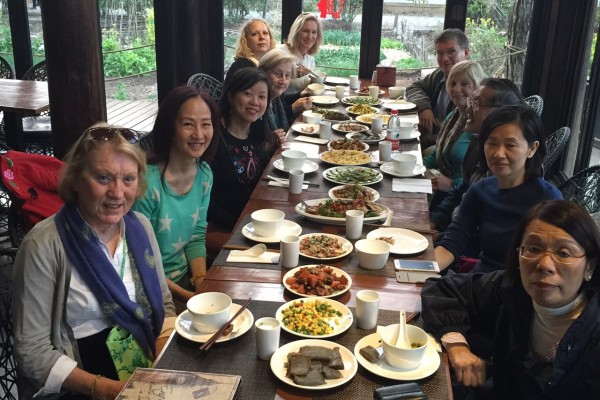
Museums Visit – by Sandra Yuen
On day one, our first visit was to the Dongba Museum where we were most fortunate to be able to view the Naxi Cultural Exhibition. The sysem of pictographic glyphs used by the Bon priests of the Naxi people of southern China was particularly interesting, just one exhibit of many, as we were guided through these wonderful cultural links to their history. The pictographs appear to be an independent ancient writing system, created by the founder of the Bon religious tradition of Tibet. From Chinese historical documents, it is clear that the script was used as early as the 7th century during the Tang dynasty and by the Sung Dynasty in the 10th century, it was used widely by the Naxi peope. Apparently it is the only pictographic language in the world still being actively maintained.
Our second day concluded with a visit to the Ancient Tea Horse Road Museum situated not far from our hotel in Lijian. This wonderful museum gave us a most interesting perspetive of the history of the ancient road. The Museum is also known as Dajuegong Palace, which used to be part of Chieftan Mu’s mansion complex in Shuhe Town during the Ming Dynasty. Eight halls exhibit the history and routes of the ancient road.
The story of the Tea Horse Road started in the 11th century in the central plains of China, when the borders of the Sung dynasty (960-1279) were threatened by barbarian invasions. At the time good quality horses were crucial to warfare and control over the territory. The Sung emperors were compelled to deal with Tibetan tribes who supplied the Chinese with these special horses and in short, this is how the ‘Tea Horse trade started.
Tea Planatation by Harriet Holbrook
The visit to the tea plantation was a lovely surprise. Sitting on Changsha Mountain with a gorgeous view of Dali and its pagodas in the distance, the small tea plantation was ready for some more than eager pickers. Our host taught us to pick only the fresh young leaves at the tip of the shoot, and sent us with baskets to our chores. While the men sat on the terrace and “supervised”, our strong women travelers waded into the neat rows of bushes and picked bright green new leaves from the tops of each plant.
Between us, we finally gathered enough and our host then taught us how to roast the leaves in several stages. The most industrious among us put on gloves and communally tossed the leaves in a large heated drum until they were roasted to perfection. We then proceeded into the beautiful stone walled tea room where our host brewed our pickings in the traditional Chinese tea ceremony style. We enjoyed the fruits of our labor as we calmly sipped some of the loveliest (and certainly the freshest) green tea ever!
Yunnan Food by Maria Ho
There were lots of local snacks available from street vendors. The more common ones were :-
1) Baba – a white potato pancake available in salty and sweet favours.
2) Naxi style fried white cheese – a soft white cheese cut into slices and then fried and served with sugar sprinkles.
3) The one you can’t miss is the fresh rose pastry – It’s a delicate flaky treat with a perfumed center of sugared rose petals.
4) We also bought strawberries and grapes that taste so fresh and delicious.
Unfortunately, our greediness meant that we were constantly full and hence didn’t have an opportunity to try the famous Cross-Bridge rice noodle “Guoqiao Mixian”. This is a traditional and famous flavour of Yunnan. It is hot soup with a layer of oil and the meat, vegetables and noodles are cooked in the hot soup in front of you.
In Lijiang, we had wild fungi and matsutake mushrooms at almost every meal, thanks to its close proximity to Shangri-la. Fresh water fish is quite common too, which is either steamed or braised in local spicy sauces.
All over Lijiang ,we can find wide varieties of fruits and vegetables in most markets, which are very fresh and tasty. However, local restaurants use lots of oil in their cooking. I have to especially mention a private kitchen we went to in Dali, whose owner and chef had spent several years in France. It is located in a neat, two-storey bamboo building in the Old Town. Some delicious dishes include shredded goat cheese with balsamic vinegar, fried Wagyu beef with green peppers, fried river shrimp with basil, and rice with black truffle. You can also find Dom Perignon there !